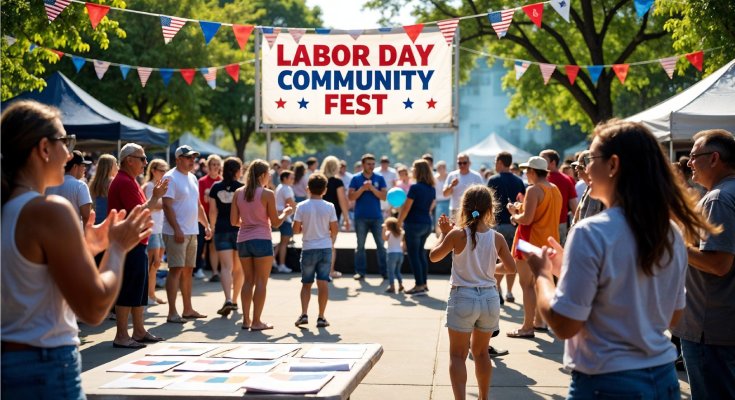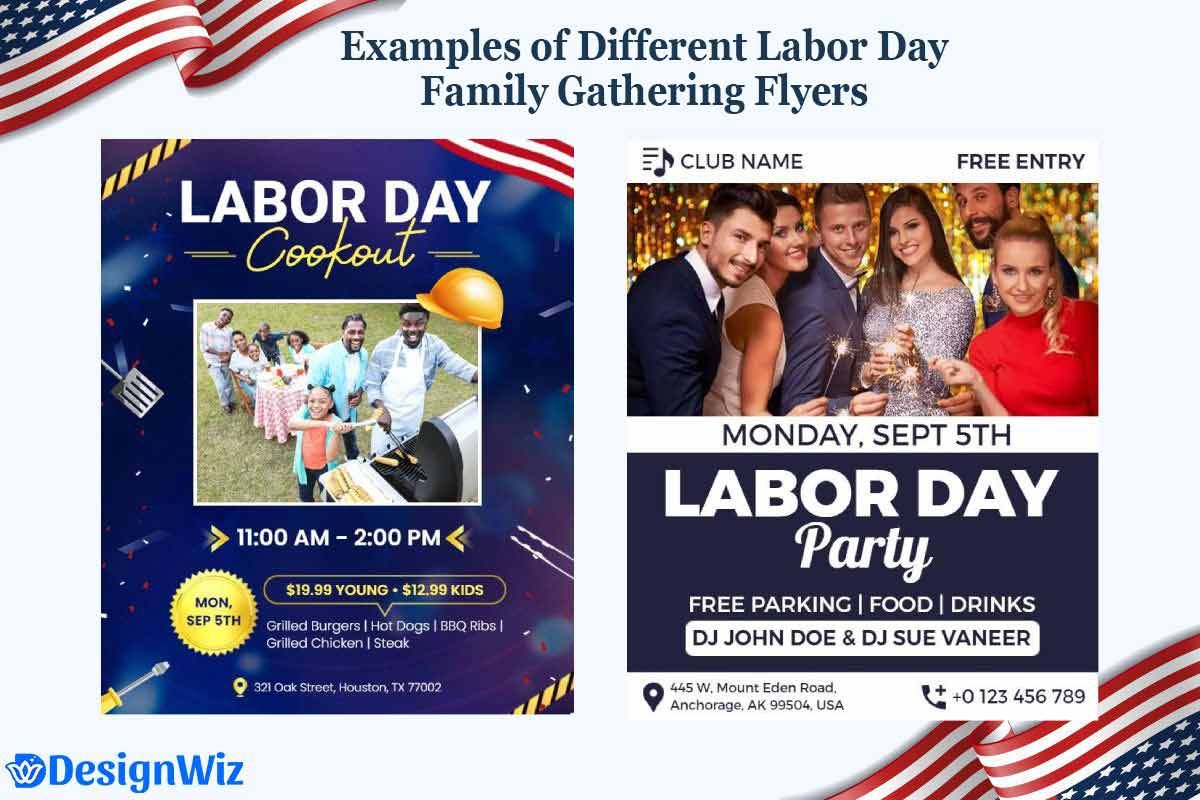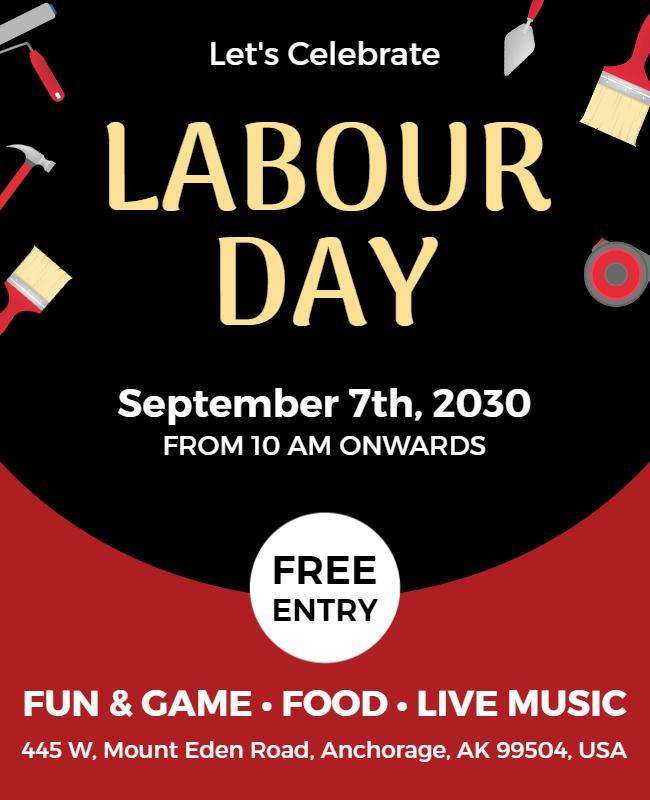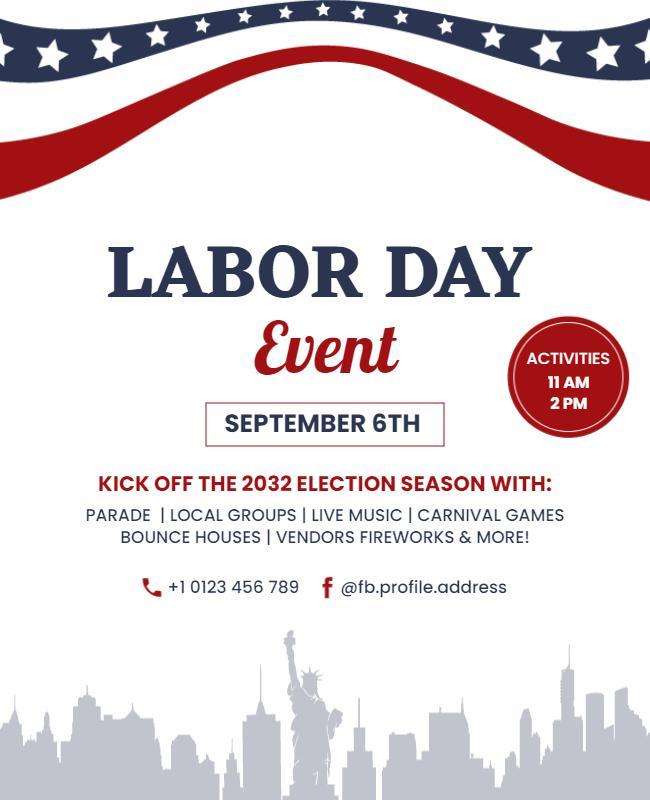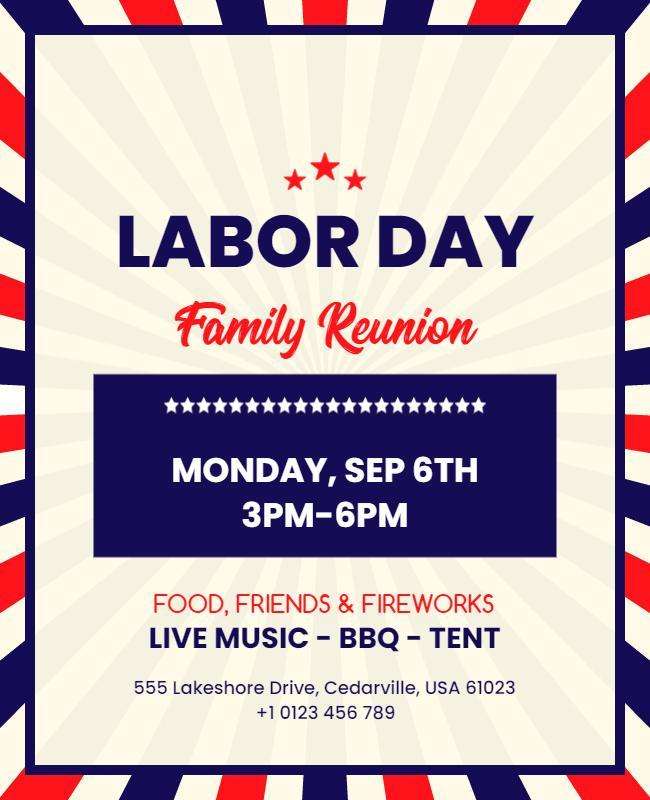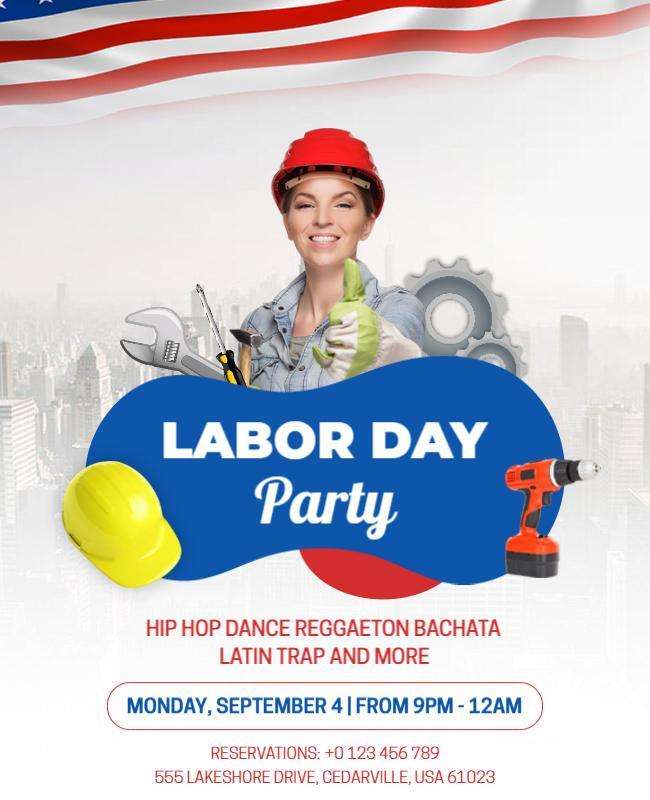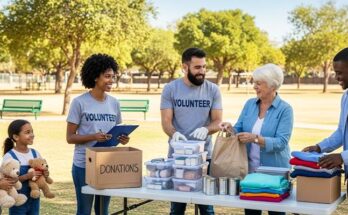Get ready-made flyer templates that bring people together—festive, bold, and perfect for your Labor Day celebration.
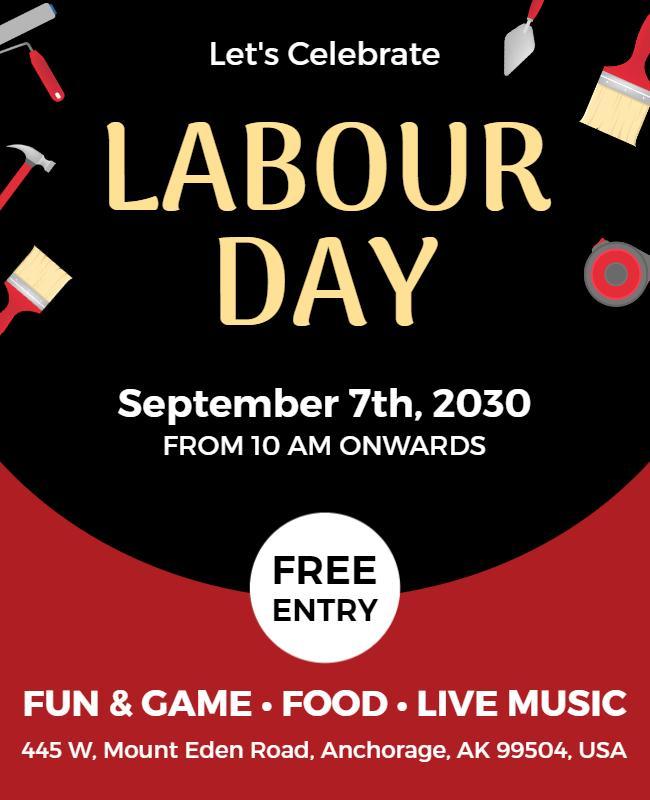

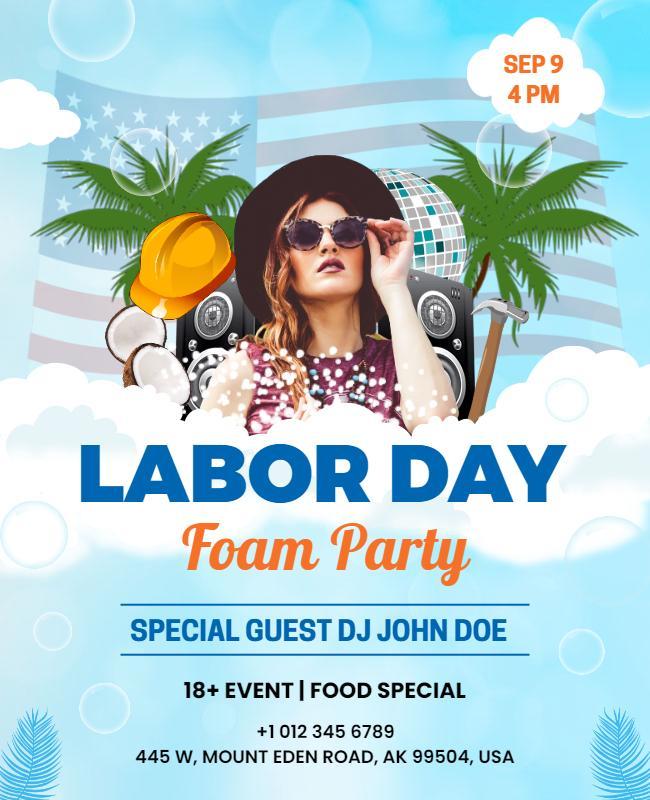
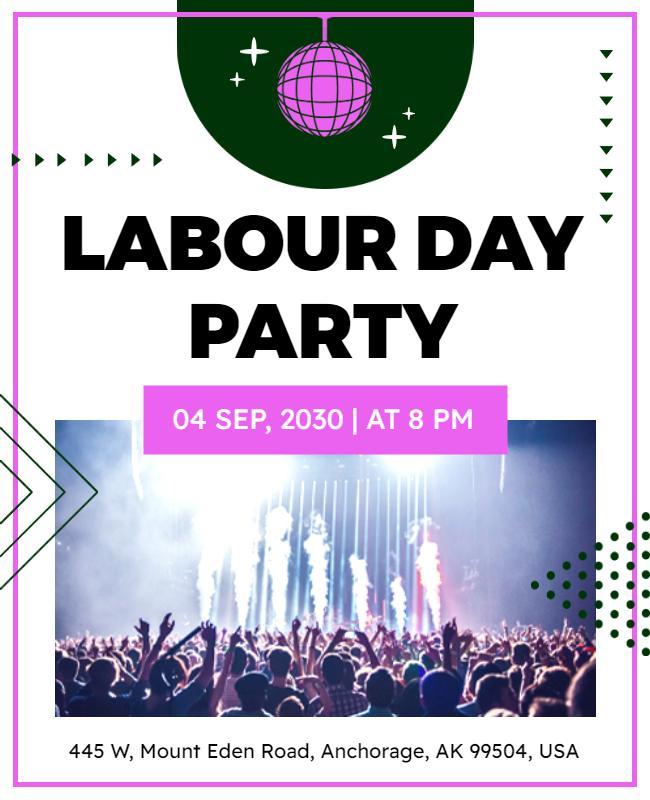
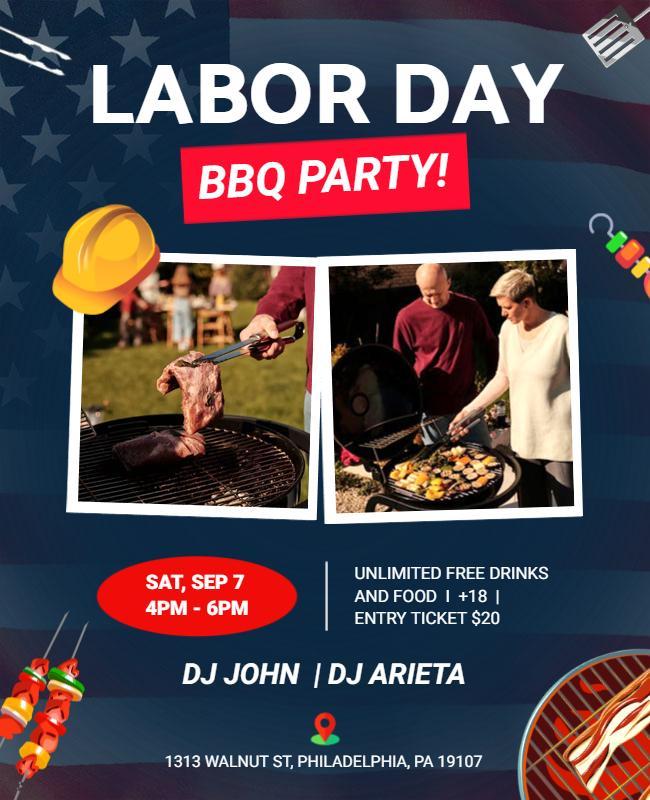
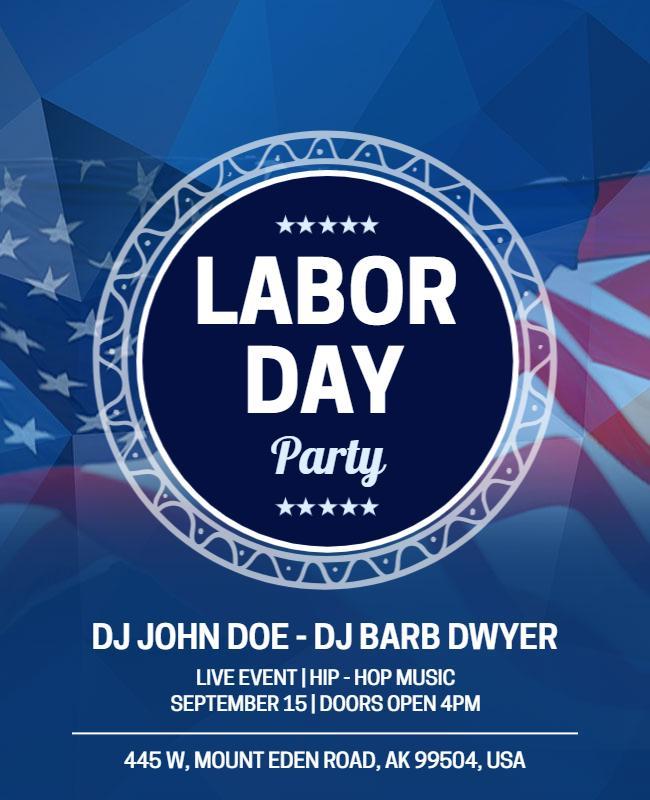
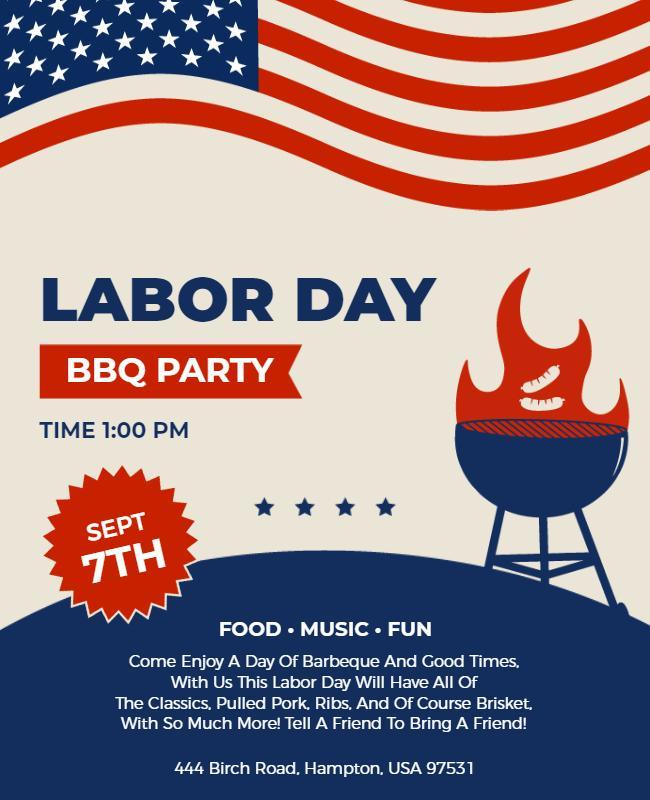
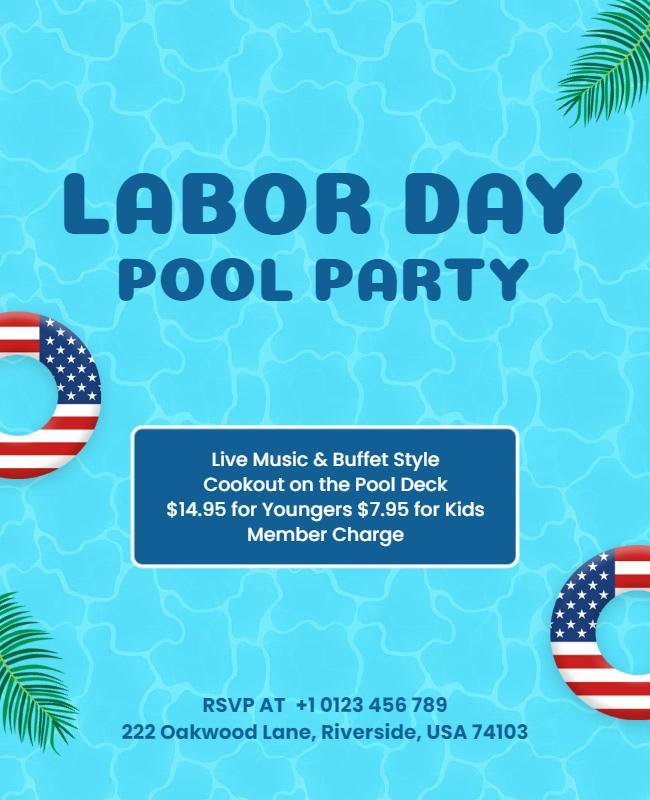
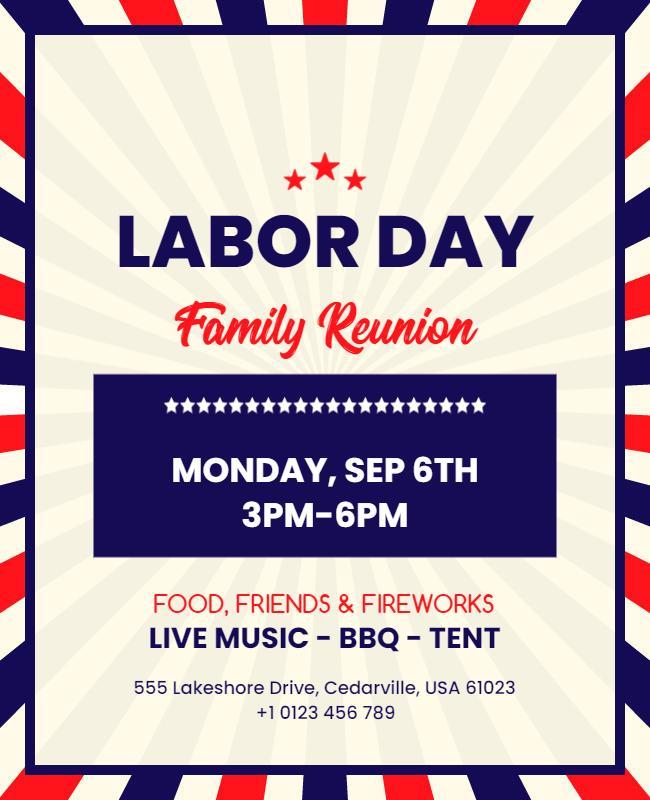
Designing effective Labor Day party flyers for community events and family celebrations requires balancing festive patriotic themes with clear event information, accessible design elements, and community-appropriate messaging. This guide covers design principles specifically for personal celebrations, neighborhood gatherings, and family-friendly events that bring communities together during America’s favorite end-of-summer holiday.
Labor Day flyers serve a fundamentally different purpose than business promotions, they build connections rather than drive sales, welcome participation rather than compete for attention, and prioritize inclusivity over conversion.
This comprehensive guide will teach you how to create inviting, accessible Labor Day party flyers that effectively communicate event details while fostering community spirit. You’ll learn family-friendly design principles, inclusive accessibility guidelines, step-by-step creation processes, and community-specific distribution strategies that ensure your celebration brings neighbors together.
How Do Community Event Flyers Differ from Business Promotions?
Community event flyers require a completely different design approach than commercial promotions, focusing on welcome and inclusion rather than persuasion and sales. Understanding these differences ensures your party flyer creates the right tone and attracts the intended audience.
Tone & Messaging Differences
- Community flyers use warm, inviting language like “Join us for…” and “Everyone welcome” rather than commercial phrases like “Don’t miss out” or “Limited time.” The goal is making people feel included in a community celebration, not pressured to take action.
Information Priorities
- While business flyers emphasize offers and benefits, community event flyers prioritize logistics that help families participate successfully, clear dates and times, accessibility information, what to bring, and whom to contact with questions. Parents need to know if activities are age-appropriate, and community members need practical participation details.
Visual Approach
- Community flyers should feel approachable and friendly rather than polished and professional. Hand-drawn elements, personal photos, and slightly imperfect layouts often work better than overly designed materials because they suggest grassroots community organizing rather than corporate marketing.
According to Lim et al. (2023), implementing visual communication accessibility guidelines, such as enhanced contrast and optimized text layouts, led to an average 12.5% faster information recognition for both low-vision and normal-vision users, highlighting the importance of inclusive visual design.1
Distribution Considerations
- Community flyers are often posted on neighborhood bulletin boards, shared in local Facebook groups, and distributed door-to-door, requiring designs that work well at various sizes and printing qualities while remaining readable from several feet away.
For comprehensive Labor Day flyer design principles that apply across all contexts, see our complete Labor Day flyer design guide.
What Essential Information Should Labor Day Event Flyers Include?
Labor Day event flyers must prioritize essential logistics while creating excitement and community appeal. Unlike business promotional flyers, event flyers serve as both information source and invitation, requiring careful balance between details and visual appeal.
Event Logistics (Primary Information)
When planning a successful Labor Day event, clear communication of essential logistical details ensures attendees feel informed, prepared, and confident about participating. From timing to accessibility, each detail plays a key role in shaping a smooth experience.
Date, Time, and Duration Details
- Display event date and time prominently using large, bold typography that’s immediately visible. Include start and end times to help families plan their day, and specify time zones if your community includes surrounding areas with different zones.
- Event duration helps attendees plan participation level and what to bring. “10 AM – 4 PM” gives different
- expectations than “10 AM -10 PM” regarding family activities, meal planning, and energy commitment.
Location and Accessibility Information
- Provide complete address with clear directions and landmark references for visitors unfamiliar with your area. Include parking details, public transportation options, and accessibility accommodations for attendees with mobility needs.
- Weather contingency information addresses outdoor event concerns that affect attendance decisions. “Rain or Shine” or “Indoor Alternative Available” messaging reduces uncertainty that prevents people from attending.
Essential Contact Information
- Include primary contact methods for questions, changes, or emergency information. Phone numbers, email addresses, and website links help attendees get additional information and build confidence in event organization quality.
- Social media handles encourage online engagement and provide platforms for real-time updates, photos, and community building around your event.
Attraction and Activity Highlights
Showcasing your event’s key attractions helps spark interest and set expectations for attendees. From entertainment to food options and family activities, these highlights can influence turnout and engagement.
Featured Entertainment and Programming
- Highlight main performers, speakers, or entertainment that differentiate your event from other Labor Day activities. Specific names and credentials build excitement and help people decide whether your event appeals to their interests.
- Schedule highlights help attendees plan their visit timing. “Live Music 2-4 PM” or “Kids Activities All Day” guides family planning and ensures people arrive when activities interest them most.
Food and Vendor Information
- Food availability significantly impacts family attendance decisions, especially for multi-hour events. Specify whether food will be available for purchase, what types of cuisine, and whether outside food is permitted.
- Local vendor participation creates community economic benefits and attracts people interested in shopping or discovering local businesses. Feature unique vendors or special event-only offerings.
Family-Friendly Activity Details
- Specify activities for different age groups to help families determine whether your event suits their children. “Kids Zone,” “Teen Activities,” and “All Ages” designations help parents plan appropriately.
- Safety information and supervision details address parent concerns about children’s activities and overall event security. This information builds confidence and encourages family participation.
Community Connection Elements
Strengthening your event’s community ties builds trust, fosters local pride, and boosts participation. Including meaningful local connections helps turn a one day event into a lasting tradition.
Local Sponsor Recognition
- Acknowledge major sponsors and community partners prominently to show community support and encourage sponsor satisfaction for future events. This recognition also signals event legitimacy and community backing.
Volunteer Opportunities
- Include volunteer information for community members who want to participate actively. Volunteer opportunities build event investment and create additional promotional ambassadors in the community.
Historical or Cultural Significance
- Connect your event to Labor Day’s meaning or local community traditions. This connection creates deeper significance beyond entertainment and builds annual tradition expectations.
Interactive Community Event Planning Calculator
Determine optimal guest counts, food quantities, and timeline requirements for your Labor Day community celebration
This comprehensive planning calculator helps you determine optimal guest counts, food quantities, and timeline requirements for your Labor Day community celebration. Simply input your event type, expected attendance, and planning timeline to receive customized recommendations.
How to Use
- Select your event type (block party, family gathering, community picnic)
- Input your expected guest count or neighborhood size
- Choose your planning timeline (4-12 weeks in advance)
- Review customized recommendations for planning success
- Download printable planning checklist with your specific requirements
This tool generates personalized planning timelines that account for permit requirements, community outreach needs, and volunteer coordination specific to your event size and scope.
How Do You Design Labor Day Party Flyers for Family Gatherings?
Family gathering flyers require special consideration for multi-generational audiences, personal touches, and clear communication of family-specific logistics. The most effective designs balance formality with warmth while ensuring essential information reaches all family members clearly.
Multi-Generational Appeal Strategies
- Use larger fonts (minimum 12-point for body text) to accommodate older family members, choose high-contrast color combinations for easy reading, and avoid trendy design elements that might confuse rather than clarify.2Traditional patriotic colors work well because they’re universally recognizable across generations.
Essential Family Event Information
- Include specific details family members need, exact address with landmarks for those unfamiliar with the location, parking arrangements, what food or items to bring, contact information for the main organizer, and any special considerations like accessibility needs or pet policies.
Personal Customization Options
- Family flyers benefit from personal touches like family photos from previous gatherings, inside jokes or family traditions references, and customized language that reflects your family’s communication style. These elements make the invitation feel special rather than generic.
RSVP and Planning Coordination
- Clearly indicate how family members should respond, whether dietary restrictions need communication, and deadlines for responses that help with planning. Include both phone and email options since family members may prefer different communication methods.
How Do You Create Flyers for Labor Day Community Events & Block Parties?
Community-wide celebrations require inclusive design approaches that welcome diverse neighbors while communicating essential logistics for successful large-group gatherings. The most effective community event flyers prioritize accessibility and clear information over decorative elements. You can easily create a flyer that gets the message across and resonates with your audience.
Inclusive Design Principles
- Use simple, clear fonts that work for all reading levels, ensure color combinations meet accessibility contrast requirements (4.5:1 minimum), and include visual elements alongside text to communicate key information. Consider that your neighbors may speak different primary languages and design accordingly.
Essential Community Logistics
- Community events require more detailed information than family gatherings, permit numbers (if applicable), emergency contact information, weather contingency plans, parking arrangements, and any community guidelines or expectations for behavior and participation.3
Neighborhood Distribution Strategy
- Design for multiple distribution methods including door-to-door delivery, community bulletin boards, and digital sharing in neighborhood social media groups. This requires ensuring your design works well both in print and on mobile device screens.
Safety and Accessibility Communication
- Include information about accessibility accommodations, emergency procedures, and any safety considerations specific to your venue or activities. Community events often include people with varying mobility needs and safety awareness.
Step-by-Step: Creating Your Labor Day Party Flyer
Creating effective Labor Day party flyers follows a systematic 6-step process that ensures both visual appeal and practical functionality for community events. This process helps you make strategic decisions while avoiding common design mistakes.
Step 1: Define Your Party Details & Audience
Clearly identify your guest demographics (families with children, seniors, young adults), event scope (intimate gathering vs. large community celebration), and formality level (casual backyard BBQ vs. organized community festival). This foundation guides all design decisions.
Step 2: Choose Your Community-Appropriate Theme
Select patriotic themes that feel welcoming rather than exclusive, incorporate community traditions or local landmarks, and ensure accessibility considerations are built into your visual approach from the beginning.
Step 3: Plan Your Information Hierarchy
Organize information by importance, event name and date most prominent, followed by time and location, then supporting details like what to bring or contact information. Use the “5-second rule”: essential information should be clear within 5 seconds of viewing.
Step 4: Design with Community Values in Mind
Choose fonts and colors that reflect inclusivity and accessibility, avoid overly commercial or polished aesthetics that might seem unwelcoming, and include visual elements that represent your community’s diversity and values.
Step 5: Optimize for Community Distribution
Prepare files for both print and digital sharing, ensure designs work well at various sizes (from 8.5×11″ down to smartphone screens), and consider how your flyer will look when photocopied or printed on home printers.
Step 6: Test with Community Members
Share drafts with neighbors representing different demographics, ask for feedback about clarity and appeal, and make adjustments based on community input before final distribution.
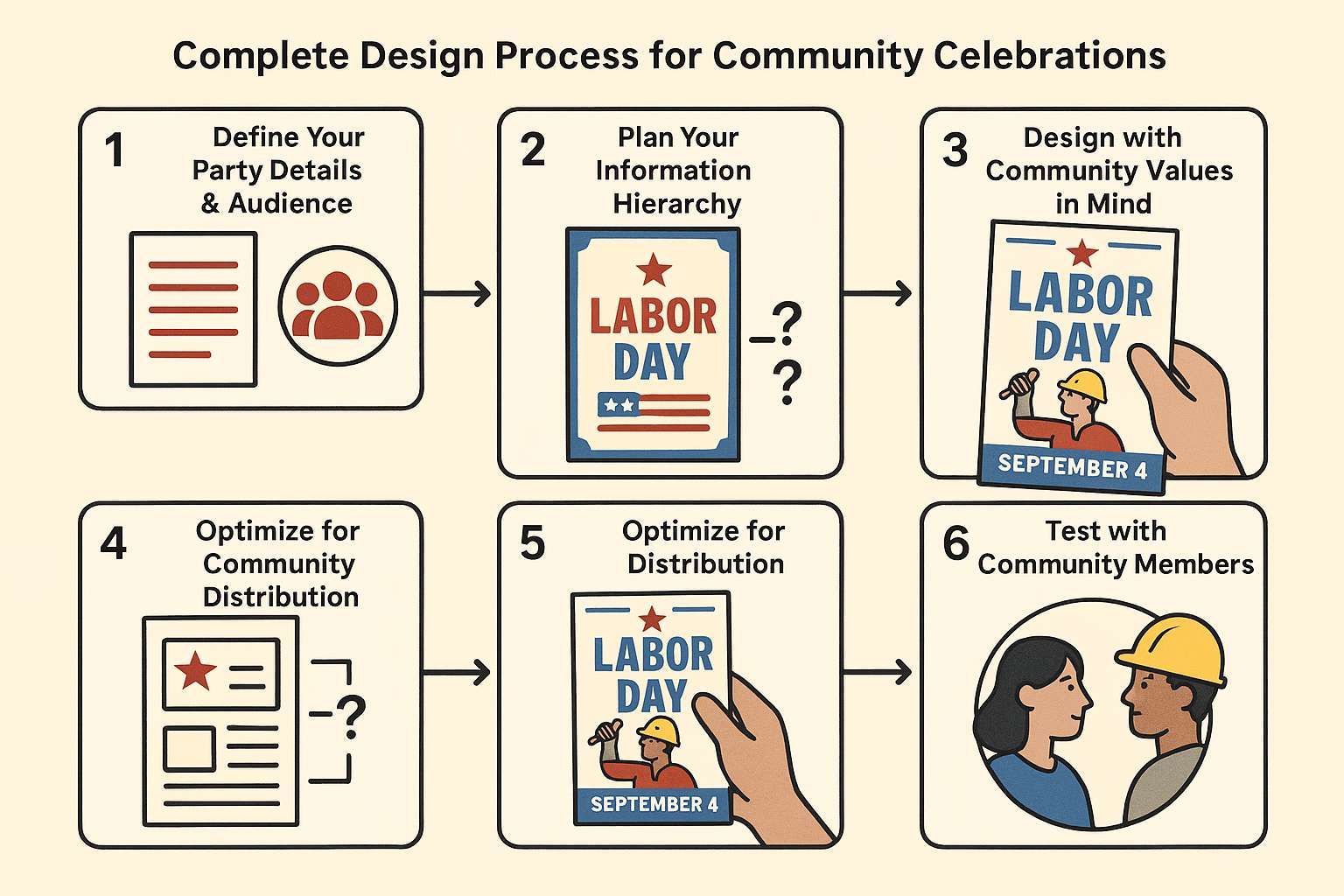
Labor Day Event Flyer Success Example
Real-world example demonstrates how effective flyer design translates into measurable community engagement and event success.
Riverside Community Labor Day BBQ Case Study
The Riverside Community Labor Day BBQ increased attendance from 150 to 400 people over three years through strategic flyer design and distribution improvements.
What They Did
- Clear information hierarchy: “Annual Labor Day BBQ” prominently displayed
- Essential logistics: “Saturday, September 2, 12-6 PM, Riverside Park”
- Family appeal: Photos showing children playing and families enjoying food
- Activity highlights: “Live Music, Kids Games, Local Food Vendors”
- Simple call-to-action: “Bring Your Family – Free Admission”
Results Achieved
- 167% increase in attendance over three years
- 40% increase in volunteer participation
- 25% increase in local business sponsorship
- Established annual community tradition
Key Success Factors
- The flyer succeeded through clear information presentation, appealing family imagery, and consistent distribution through local businesses and schools. Professional design quality signaled well-organized event while maintaining community-friendly appeal.
What are the Most Effective Labor Day Event Flyer Designs by Event Type?
Different Labor Day events require distinct design approaches that match audience expectations and event characteristics. Understanding these differences helps create flyers that attract appropriate attendees and set correct expectations.
Community Festivals and Celebration Flyers
Designing flyers for community festivals involves capturing the spirit of togetherness while clearly presenting event details. A thoughtful layout and inclusive visuals help ensure broad appeal and easy readability.
Design Approach for Large Community Gatherings
- Community festivals require flyers that convey celebration atmosphere while managing complex information about multiple activities, vendors, and time schedules. Use organized sections and clear visual separation between different festival elements.
- Create excitement through dynamic imagery and color schemes while maintaining professional organization that builds confidence in event planning quality. Balance fun atmosphere with practical information needs.
Family-Oriented Visual Elements
- Feature imagery showing multi-generational participation: children playing, families together, seniors enjoying activities. This representation helps different age groups envision their place in your event.
- Use welcoming, inclusive design elements that avoid excluding any community segments. Represent diversity in imagery and avoid assumptions about family structures or cultural backgrounds.
Sponsor Recognition Integration
- Design sponsor acknowledgment that provides promised recognition without overwhelming event information. Create dedicated sponsor sections or integrate sponsor logos tastefully throughout the design.
- Balance sponsor visibility requirements with attendee information needs. Sponsors deserve recognition, but attendee information clarity remains the primary flyer purpose.
According to the University of Maryland’s accessibility guidelines, flyers should feature clear typography, high-contrast design, and concise layouts to support individuals with disabilities benefits that improve access for all. In fact, events that implement accessible communication strategies experience up to 35% higher attendance and participation rates from diverse community groups.4
Labor Day Parade and Civic Event Flyers
Parade and civic event flyers play a key role in uniting communities around shared traditions. A thoughtful design ensures attendees are informed, engaged, and inspired to participate meaningfully in the celebration.
Patriotic Design Elements and Appropriate Imagery
- Parade flyers naturally incorporate more patriotic imagery than other event types, but maintain tasteful balance that honors the holiday without appearing overly political or exclusive.
- Use historical imagery, flag elements, and patriotic colors respectfully and in accordance with proper flag display guidelines. Educational elements about Labor Day’s significance add depth and community value.
Route Information and Viewing Recommendations
- Provide clear parade route maps or descriptions that help spectators choose optimal viewing locations. Include parking suggestions, restroom locations, and accessibility considerations for parade viewing.
- Specify parade timing, duration, and any street closures that affect transportation. This information helps community members plan participation and avoid traffic complications.
Community Participation and Historical Context
- Highlight opportunities for community involvement beyond watching: marching groups, volunteer positions, or related activities. This participation builds community investment and annual tradition continuity.
- Connect your parade to Labor Day’s historical significance and local community traditions. This context creates deeper meaning and educational value beyond entertainment.
Outdoor Recreation and Sports Event Flyers
Flyers for outdoor recreation and sports events must reflect the excitement of physical activity while clearly communicating essential logistics. A well-designed flyer sets the tone for participation, safety, and preparation.
Active Lifestyle Imagery and Energy Communication
- Use dynamic, energetic imagery that represents your specific activities and skill levels. Show actual participants when possible to demonstrate inclusivity and appropriate skill expectations.
- Balance energy and excitement with safety and accessibility information. Active events require more detailed safety and preparation information than passive community gatherings.
Registration and Equipment Requirements
- Clearly specify registration deadlines, fees, and processes for events requiring advance sign-up. Include equipment needs, skill level requirements, and any provided vs. participant-supplied items.
- Safety information becomes crucial for active events: required safety gear, medical requirements, emergency procedures, and weather policies. This information builds confidence and ensures appropriate participation.
Weather Considerations and Contingency Plans
- Outdoor recreation events face unique weather vulnerability requiring clear contingency communication. Specify rain policies, extreme heat procedures, and how participants learn about weather-related changes.
Cultural and Arts Event Flyers
Cultural and arts event flyers should reflect the tone, quality, and purpose of the programming they promote. Design choices must appeal to an audience seeking meaningful and enriching experiences.
Sophisticated Design Reflecting Programming Quality
- Cultural events require design sophistication that matches programming quality and attracts audiences seeking intellectual or artistic experiences. Use elegant typography and refined color palettes.
- Feature performer or artist credentials, educational value, and cultural significance to attract appropriateaudiences and set quality expectations.
Artist and Performer Highlighting
- Provide sufficient artist recognition to build audience interest while maintaining design balance. Include relevant credentials, performance highlights, or educational background that builds attendance motivation.
- Educational Value and Community Enrichment: Emphasize learning opportunities, cultural exposure, and community enrichment benefits that distinguish cultural events from pure entertainment options.
Labor Day Event Flyer Strategy Integration
Creating effective Labor Day event flyers works best when integrated with comprehensive community engagement and promotional strategies that extend beyond single-event marketing.
Connecting Event Flyers with Broader Community Engagement
Your Labor Day event flyer should align with year-round community engagement efforts, building on existing relationships and communication channels while establishing connections for future events and community involvement.
Expanding Beyond Event Promotion
Many event organizers also coordinate with local businesses or restaurants for food service and vendor partnerships. If you’re working with food service providers or restaurants for your Labor Day event, our Labor Day BBQ & Restaurant Flyers guide provides strategies for coordinating promotional materials that benefit both events and business partners.
Community events often inspire local businesses to create complementary promotions and sales. For retail business coordination and cross-promotional opportunities, our Labor Day Flyers for Small Retail Businesses guide offers strategies for building mutually beneficial promotional partnerships.
Labor Day Community Event Flyer Gallery: Design Inspiration & Examples
This comprehensive collection showcases 50+ professional Labor Day community event and family celebration flyer designs. Each example demonstrates specific design principles for inclusive, accessible community celebration materials.
- Labor Day Community Cookout Event Flyer
- Labor Day Family Reunion Celebration Flyer
- Labour Day Celebration Event Flyer
- Labor Day Foam Party Event Flyer
- Labor Day Kids Activities Event Flyer
- Labour Day Celebration Party Flyer
- Labor Day Barbecue Event Flyer
- Labor Day Bbq Party Celebration Flyer
- Labor Day Pool Party Celebration Flyer
- Labor Day Party Event Announcement Flyer
- Labor Day Festive Red and Navy Beach Party Flyer
FAQs About Labor Day Community Event Flyers
Start planning community Labor Day events 6-8 weeks in advance to allow time for permits, community outreach, volunteer coordination, and flyer distribution throughout the neighborhood. This timeline ensures adequate preparation and maximizes community participation through proper advance notice and planning.
Standard 8.5×11-inch flyers work best for community distribution because they’re easily readable when posted on bulletin boards, fit standard home printers, and provide adequate space for essential event information. Smaller sizes may not include enough detail for community logistics, while larger sizes become difficult to distribute door-to-door.
Ensure accessibility by using high-contrast color combinations (minimum 4.5:1 ratio), choosing clear, readable fonts at least 12-point size, including both visual and text elements to communicate key information, and considering multilingual elements if your community includes non-English speakers. Test readability with community members of different ages and abilities.
Yes, always include emergency contact information for community events, including the main organizer’s phone number, backup contact person, and any relevant emergency services information. Community events often involve larger groups and potential safety considerations that require clear emergency communication protocols.
Combine multiple distribution methods: door-to-door delivery for immediate neighbors, posting on community bulletin boards in high-traffic areas, sharing in neighborhood social media groups and apps like Nextdoor, and asking early responders to share with their networks. Different community members prefer different communication channels.
Prioritize essential information in the most prominent design positions, use visual hierarchy to guide readers through information logically, and incorporate fun elements as supporting design elements rather than primary focus. Essential details should be readable within 5 seconds, with decorative elements enhancing rather than competing with key information.
People Also Ask
What colors work best for Labor Day party flyers?
Red, white, and blue remain the classic choice for Labor Day flyers, but consider using deeper patriotic tones like navy blue, burgundy, and cream for a more sophisticated look. You can also incorporate seasonal late-summer colors like warm oranges, golden yellows, and earth tones to reflect the end-of-summer celebration aspect of Labor Day.
What Labor Day symbols should I include on my community flyer?
Consider incorporating symbols that represent both patriotism and workers’ rights: American flags, stars and stripes patterns, tools representing various trades, BBQ grills for the holiday aspect, and community imagery like hands joining together. Avoid overly political imagery and focus on celebration and unity themes.
What legal information should I include on community event flyers?
Include permit numbers if required by your locality, liability disclaimers for community events, alcohol policies if applicable, and any age restrictions. Add contact information for questions about accessibility accommodations and mention if the event follows local health guidelines. Check with your local community association about specific requirements.
What’s the best file format for printing and sharing Labor Day flyers?
Save your design as a high-resolution PDF for professional printing, PNG files for online sharing and social media posting, and keep an editable version in your design software for last-minute updates. PDFs maintain quality across different devices and printers, while PNGs work well for digital distribution and maintain transparency if needed.
Conclusion
Creating effective Labor Day community event flyers combines inclusive design principles with clear communication and community-appropriate messaging. By following the accessibility guidelines, step-by-step design process, and community-specific strategies outlined in this guide and by using our editable flyer templates, you’ll create promotional materials that welcome all neighbors and ensure successful community celebrations.
Key takeaways for community event flyer success:
- Prioritize accessibility and inclusion in all design decisions
- Focus on clear information hierarchy with essential details prominently displayed
- Use warm, welcoming language that builds community connection
- Test designs with diverse community members before final distribution
- Plan distribution through multiple channels to reach all neighbors
Reference
- Lim, J., Kim, W., Kim, I., & Lee, E. (2023). Effects of Visual Communication Design Accessibility Guidelines for Low Vision. National Library of Medicine.
- Princeton University Digital Accessibility Office. (2024). “Color Considerations: Design Guidelines for Digital Accessibility.” Digital Accessibility at Princeton.
- Office of Compliance, University of Wisconsin-Madison. (2023). “Guide to Planning an Accessible Event.” Accessibility and Compliance Resources, University of Wisconsin-Madison.
- “Best Practice Guidelines for Planning an Accessible Event.” Retrieved June 17, 2025. University of Maryland Accessibility.
